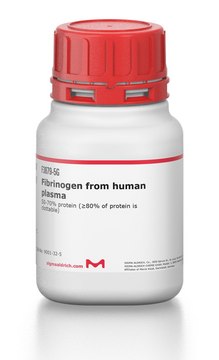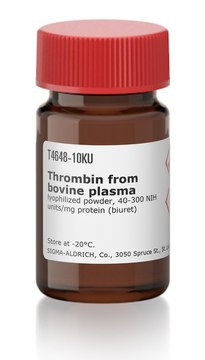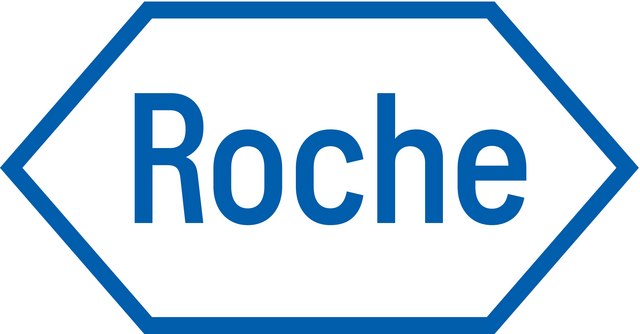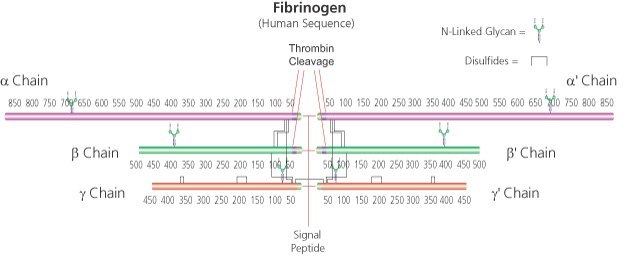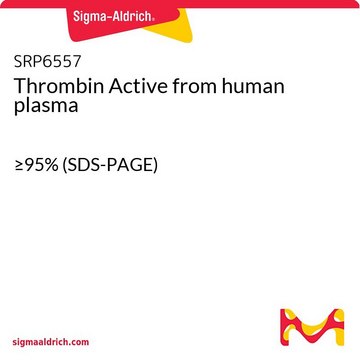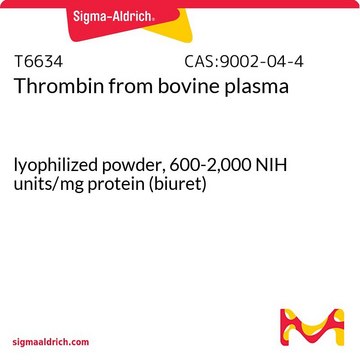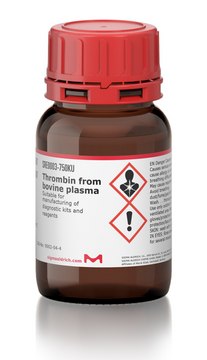T6884
Thrombin from human plasma
lyophilized powder, ≥2,000 NIH units/mg protein (E1%/280, 18.3)
Synonym(s):
Factor IIa
Sign Into View Organizational & Contract Pricing
All Photos(1)
About This Item
Recommended Products
biological source
human plasma
Quality Level
form
lyophilized powder
specific activity
≥2,000 NIH units/mg protein (E1%/280, 18.3)
mol wt
37.4 kDa
impurities
HIV and HBsAg, source material tested negative
UniProt accession no.
storage temp.
−20°C
Gene Information
human ... F2(2147)
Looking for similar products? Visit Product Comparison Guide
General description
Thrombin is produced from the proteolytic cleavage of inactive prothrombin in the liver. It is a glycoprotein with four structural domains: the 10 γ-carboxylated glutamic acid containing Gal domain, two kringle domains, and the trypsin-like serine protease domain. The prothrombin gene is mapped to human chromosome 11p11.2.
Thrombin is the final coagulation protease in regard to hemostasis, promoting both procoagulant and anticoagulant effects.
Application
Thrombin from human plasma has been used:
- in the preparation of fibrin gels for assessing human bone marrow stromal cells (hBMSC) morphology,
- in the activation of platelets,
- to evaluate the integrity of endothelial cell (EC) monolayers
Thrombin is used for site specific cleavage of recombinant fusion proteins containing an accessible thrombin recognition site for removal of affinity tags.
Biochem/physiol Actions
Serine protease that selectively cleaves Arg-Gly bonds in fibrinogen to form fibrin and fibrinopeptides A and B.
The main function of thrombin is the cleavage of fibrinogen to fibrin, to assist stable clot formation. A wide range of mutations in the prothrombin gene contributes to its deficiency resulting in coagulation disorders like dysprothrombinemia and hypoprothrombinemia. High levels of thrombin elicit neurotoxicity in dopaminergic neurons and contributes to the progression of Parkinson′s disease. Altered thrombin levels modulates the coagulation pathway in multiple sclerosis. Patients with coronary artery disease (CAD) show elevated levels of thrombin. Thrombin accumulation in neurofibrillary tangles of the brain may contribute to the aggregation of tau protein and pathophysiology of Alzheimer disease.
Thrombin is used for site specific cleavage of recombinant fusion proteins containing an accessible thrombin recognition site for removal of affinity tags. Thrombin has been used in a study to investigate the protein C pathway in intestinal barrier function.
Unit Definition
Activity is expressed in NIH units obtained by direct comparison to a NIH Thrombin Reference Standard
Physical form
Lyophilized from saline sodium citrate buffer, pH 6.5
Analysis Note
The NIH assay procedure uses 0.2 ml diluted plasma (1:1 with saline) as a substrate and 0.1ml of thrombin sample (stabilized in a 1% buffered albumin solution) based on a modification of the method of Biggs. Only clotting times in the range of 15-25 seconds are used for determining thrombin concentrations.
Other Notes
View more information on thrombin at www.sigma-aldrich.com/enzymeexplorer.
Disclaimer
RESEARCH USE ONLY. This product is regulated in France when intended to be used for scientific purposes, including for import and export activities (Article L 1211-1 paragraph 2 of the Public Health Code). The purchaser (i.e. enduser) is required to obtain an import authorization from the France Ministry of Research referred in the Article L1245-5-1 II. of Public Health Code. By ordering this product, you are confirming that you have obtained the proper import authorization.
inhibitor
Product No.
Description
Pricing
Signal Word
Danger
Hazard Statements
Precautionary Statements
Hazard Classifications
Eye Irrit. 2 - Resp. Sens. 1 - Skin Irrit. 2 - STOT SE 3
Target Organs
Respiratory system
Storage Class Code
13 - Non Combustible Solids
WGK
WGK 2
Flash Point(F)
Not applicable
Flash Point(C)
Not applicable
Choose from one of the most recent versions:
Already Own This Product?
Find documentation for the products that you have recently purchased in the Document Library.
Customers Also Viewed
Our team of scientists has experience in all areas of research including Life Science, Material Science, Chemical Synthesis, Chromatography, Analytical and many others.
Contact Technical Service